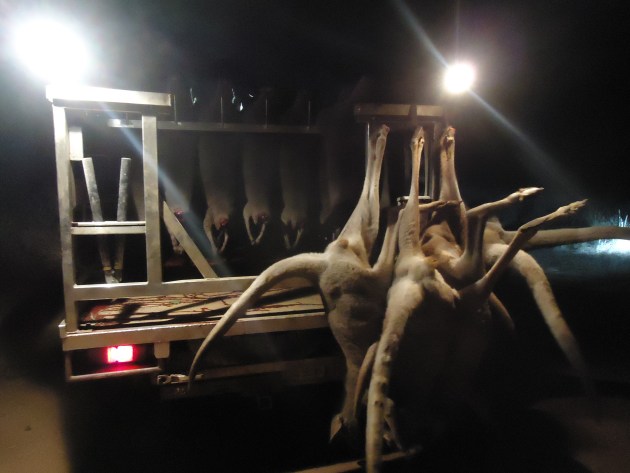In many parts of Australia, kangaroo numbers have declined to less than the quasi-extinction density of five kangaroos per square kilometre, the nominal value of kangaroo densities taken to indicate the effective loss of the species (Hacker et al, 2004, p.62).
Critical minimum densities are not clearly defined but populations below 2 kangaroos per square kilometre would generally be considered at risk of extinction (Hacker et al,2004, p47 ).
Red Kangaroos only grow at a rate of 6-8% per year. Therefore they are being killed at a rate three times faster than they can breed (McLeod, UNSW, Kangaroo Myths and Realities, 2001,p. 104).
The commercial hunting of red kangaroos is unsustainable.
South Australia
According to government surveys. in 2018, the region known as Marree (inside the dog fence) had a red kangaroo population of 261,010. In 2019, the same region had a red kangaroo population of 46,536. The number of red kangaroos declined by 214,474 (82%). There are now 3 red kangaroos per square kilometre. Yet, commercial hunting continues at a quota of 17% or 7,900.
In 2018, the region known as Marree (outside the dog fence) had a red kangaroo population of 90,534. This number is the equivalent to half a kangaroo per square kilometre. Populations below 2 kangaroos per square kilometre would generally be considered at risk of extinction (Hacker et al,2004, p47 ). Red kangaroos weren’t surveyed in this region during 2019, so the number of red kangaroos is unknown. Yet, commercial hunting continues at a quota of 10% or 9,000.
Western Australia
The Kangaroo Management Plan for Western Australia states:
It is important to note that the density estimates of kangaroos over much of Western Australia, particularly in rangelands areas, are significantly lower than in eastern Australia. Average densities in many areas of Western Australia are of the order of one kangaroo per square kilometre or lower, with average red kangaroo density estimates at the PMZ level ranging from less than 0.4 kangaroos per square kilometre to a high of around three kangaroos per square kilometre.
In 2018, the northern region had a red kangaroo population of 602,310. In 2019, the number of red kangaroos was estimated at approximately 300,000. Numbers have declined by around 50%. Yet, commercial hunting continued at 53,350 or 17%.
New South Wales
The 2020 quotas haven’t been set by the New South Wales Government.
Fires in New South Wales have so far destroyed five million hectares and injured or killed approximately 500 million wildlife.
For instance, in November 2019, a bushfire tore through the Mount Kaputar National Park near Narrabri, destroying 18,000 hectares, half of the national park.
In Narrabri, in 2016, estimated red kangaroo numbers were 780,834. This figure equates to 11.9 kangaroos per square kilometre. In 2019, the estimated number of red kangaroos plummeted to 346,451. Even before the November 2019 bushfire that destroyed half of the national park, red kangaroos had declined to the quasi-extinction density of five kangaroos per square kilometre.
In Tibooburra, in 2016, estimated red kangaroo numbers were 1,567,598. This figure equates to 30.2 kangaroos per square kilometre. In 2019, the estimated number of red kangaroos crashed to 79,346, the equivalent of 1.44 red kangaroos per square kilometre. Tibooburra is an example of how quickly kangaroo numbers can decline to the point of extinction within a region. These dramatic declines are happening throughout Australia.
In 2016, Cobar had an estimated red kangaroo density of 10.8 kangaroos per square kilometre or a total of 437,129. Numbers plunged to 36,058 in 2019, which is a density of 0.89 kangaroos per square kilometre.
Healthy populations of kangaroos can disappear within three or four years. Commercial harvesting is another threat these kangaroos cannot survive.
Queensland
Much of Queensland’s commercial harvest zones have now been drought declared for seven consecutive years.
The common wallaroo, commercially harvested in Queensland, is on the brink of extinction in 95% of Queensland.
In 2013, the density of common wallaroos in Blackall was estimated at 54.43. Six years later, the density was estimated at 3.44, well below the quasi-extinction density of 5 kangaroos per square kilometre.
In 2013, the density of common wallaroos in Charleville was estimated at 10.65. In 2019, six years later, the density was estimated at 0.60, placing the common wallaroo at risk of extinction.
Cunnamulla had an estimated red kangaroo density of 28.76 in 2013. Over the next six years, numbers of red kangaroos plunged so much that the 2019 estimated density is 5.56. This once healthy population is now quasi-extinct.
The density of red kangaroos in Windorah during 2013 was 11.84. Six years later, red kangaroos are on the brink of extinction in this region at a density of 3.22 kangaroos per square kilometre.
Victoria
Since the 2019/20 bushfires devastated parts of Victoria, the state government has placed a hold on the culling of kangaroos. Well done, Victoria.
Copyright © 2024 | WordPress Theme by MH Themes


Leave a Reply